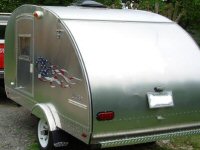Esteban wrote:There are other ways to wire it, without a second breaker used as a converter breaker, that I am attempting to learn about.
I'd be
very interested in reading about that.
The
only other way I can think that is even possible (
although I have very very serious doubts as to its correctness) is to connect your shore power hot (black) directly to the bus bar that the breakers plug on to. This would let you use your 30A breaker for your converter, and then use your 15A breakers for whatever branch circuits you have. (I strongly suggest against this)
HOWEVER, the PD4045 instructions specifically call for a 30A Main Breaker for a reason.By definition, a main breaker's purpose is to work as a disconnect for 100% of the AC power going to an breaker panel (the PD4045 in our instance). Connecting the shore power directly to the breaker bus bar as I just described above completely defeats the main breakers purpose and I have zero doubt in my mind that this could
void any warranty on your unit because its not wired as designed.
Not to mention that the PD4045 converter/charger doesn't require anywhere near 30A. Per the instruction manual, its rated input at 105-130VAC is only 725W, which is a
maximum of 7A.
If you really need want more than two AC branch circuits for outlets then pick up a few tandem breakers and do it right. They're just about twice the cost of a regular breaker (because it really is two breakers in one). That will allow you to have the maximum of a 30A main, a 15A converter breaker, and six 15A circuits for outlets. Why anyone would need 6 branch circuits in a tiny trailer like ours is beyond me.
I know you're planning on using GFCI outlets which is a good thing. You can daisy-chain multiple outlets on each branch circuit, and only the first one needs to be a GFCI. So the more circuits you separate your outlets into, the more GFCI outlets you'll need (more $$). Unless you have some
really big items pulling some
serious power (
at exactly the same time), then you'll be best off keeping your AC branch circuits to a minimum for ease of wiring and to keep costs down. I don't know exactly what your plans are, but there's really no need to run an individual outlet on each branch circuit.
For example: MAYBE if you're planning on running a
full size microwave (~1200W @ 10A), a heavy duty coffee maker, and a 1000W blow dryer (~8.3A)
at the same time, then you might separate these circuits onto their own breakers. But that's probably an exaggerated situation for someone who is camping. I know some people have microwaves, but I've never seen someone with a full-size microwave.
That's all I have to say about this subject. I really can't explain it any better. Just trying to help KISS.







 Zach thank you for your detailed reply. I think SOME of the confusion comes about because each of us is setting up our electrical systems differently to meet our own needs. I wish I had the ability to visually draw up my plan similar to how you have drawn up yours. I've tried to learn to use SketchUp to no avail so far...I'm still in the deep confusion stage when I attempt to use it.
Zach thank you for your detailed reply. I think SOME of the confusion comes about because each of us is setting up our electrical systems differently to meet our own needs. I wish I had the ability to visually draw up my plan similar to how you have drawn up yours. I've tried to learn to use SketchUp to no avail so far...I'm still in the deep confusion stage when I attempt to use it. Your two illustrations seem to differ (in my opinion). Your top one shows the second breaker from the left as a "converter breaker". Your lower one shows a 15A breaker in the same position powering an AC circuit with two AC outlets...which is how I (think) I will set up my wiring.
Your two illustrations seem to differ (in my opinion). Your top one shows the second breaker from the left as a "converter breaker". Your lower one shows a 15A breaker in the same position powering an AC circuit with two AC outlets...which is how I (think) I will set up my wiring. Progressive Dynamics seems to have different versions of the PD4045 that are wired differently. When I Google for information, and see photos of different versions of PD4045s, to learn how to set mine up that adds to my (ongoing) confusion. I think because I'll have an external kill switch on the DC power cable from the battery that there is an alternate way to correctly wire the battery lugs and the "DC DISC" on the PD4045...that I need to learn about to do it right without a "smoke test."
Progressive Dynamics seems to have different versions of the PD4045 that are wired differently. When I Google for information, and see photos of different versions of PD4045s, to learn how to set mine up that adds to my (ongoing) confusion. I think because I'll have an external kill switch on the DC power cable from the battery that there is an alternate way to correctly wire the battery lugs and the "DC DISC" on the PD4045...that I need to learn about to do it right without a "smoke test."